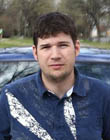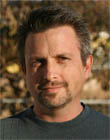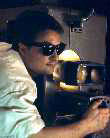|
|
This topic comprises 2 pages: 1 2
|
|
Author
|
Topic: Screens of 80 foot width...
|
|
|
|
|
|
|
|
|
Steve Scott
Phenomenal Film Handler

Posts: 1300
From: Minneapolis, MN
Registered: Sep 2000
|
 posted 04-20-2006 10:40 AM
posted 04-20-2006 10:40 AM




In Minneapolis there are four 80 ft. (give or take) monsters. Carmike has two of them in their 15-plexes on the north & south sides of the metro, Marcus has their Ultrascreen on the northeast side of St. Paul, and Mullers just finished their "monster screen" at my old home Lakeville.
The Carmike machines run 4.5 or 5K bulbs (I think) with basic Christie machines. The results are shaky, scratched & for years the digital sound wouldn't kick over. Sadly, these were the only THX houses too.
I haven't seen Lakeville's new monster yet. I'd heard installers were trying to talk up a JJ/cinefocus setup on a 4.5K bulb, but Muller ended up going with an SA brought down from the White Bear Township theatre & some German 6K bulb. A QSC tri-amp crossover was also supposed to be installed behind the screen. The cinefocus setup also went by the wayside. I've heard good things, but I thought they'd drop the 'monster screen' billing from their ads. It's a circus in the suburbs.
Marcus has a good setup with a Kinoton machine, not sure of the bulb. Some coworkers of mine saw Serenity there & only complained about the fader being set too low for such a setup. They are THX triamped.
Most of these auditoria have a square design, rather than being long & narrow. I don't like these. It gives an IMAX, right up there effect, unless you're toward the back of the house, which just doesn't sit right with me for 35mm.
| IP: Logged
|
|
John Pytlak
Film God

Posts: 9987
From: Rochester, NY 14650-1922
Registered: Jan 2000
|
 posted 04-20-2006 12:52 PM
posted 04-20-2006 12:52 PM





To give some idea of the challenge of lighting an 80-foot wide screen properly, with typical 35mm projection efficiencies, a matte white (gain=1) screen would need close to a 15,000 watt lamp to light a 80 X 33.5 foot screen --- of course, if there were such a lamphouse, the 0.825 X 0.690 inch frame of 35mm film would suffer severe heat damage. ![[Eek!]](eek.gif)
In practice, a 6K or 7K lamp with an efficient optical system and very efficient heat filter, a water cooled gate, high efficiency lens, and properly curved/tilted high gain screen may barely get you to the low end of the tolerance allowed by standard SMPTE 196M. ![[thumbsdown]](graemlins/thumbsdown.gif)
This is really a job for 70mm film!!! ![[thumbsup]](graemlins/thumbsup.gif)
| IP: Logged
|
|
|
|
|
|
|
|
|
|
|
|
|
|
|
|
Frank Angel
Film God

Posts: 5305
From: Brooklyn NY USA
Registered: Dec 1999
|
 posted 04-21-2006 12:50 AM
posted 04-21-2006 12:50 AM





There's a company called Technilite or something similar who claim to have developed a proprietary bulb/reflector system that increases light output by 1/3 more. It is being installed primarily in light-starved Drive-ins where an 80 foot screen is nothing out of the ordinary. Of course they don't get near the 16fl goal either; in fact, the SMPTE gave up that goal and only aims for 12ftl. Nor do DIs have the advantage of high gain screens (they paint corrigated steel or plywood with white paint -- gain of 1.0 at best).
So seeminly if DIs can get viewable pictures on those mamouth screens with whatever new technology this Technilite uses, it is conceivable that an indoor with the advantages it has of controllable ambient light, high gain screen properly curved and tilted, an 80 footer should be do-able. But then again, at what cost in image degradation due to such extreme magnification, especially if you a pushing seats up right up to the screen at the same distances that those shoebox theatres do, in other words, way WAY to close. Theatre designers seem to put those first rows at the same insanely close distance with total disregard to the screen size, matter if it is a 25ft screen or a 60ft screen -- the first rows are almost never at the SMPTE recommended distance, which is supposed to be determined by the screen size, not how close they can get the first row and still let people pass across it.
Knocking down the screen size in this hypothetical new build to 65 or 70 feet might move it enough away from the everything-is-super-critical-and-right-on-the-edge-of-scorching-the-film, and into the realm of reasonable. Wouldn't it be better to have a slightly smaller screen with a noticably superior image than a monster screen with a mediocre image?
| IP: Logged
|
|
John Pytlak
Film God

Posts: 9987
From: Rochester, NY 14650-1922
Registered: Jan 2000
|
 posted 04-21-2006 08:56 AM
posted 04-21-2006 08:56 AM





For screening rooms, standard SMPTE 196M specifies the preferred viewing distance is between 2 and 4 times the height of the image. So for a 20 X 48 foot screen, the preferred viewing distance is between 40 and 80 feet from the screen, along the centerline of the theatre. Of course, most theatres have additional seats closer than this distance, and farther than this distance.
quote: Andrew McCrea
Do they actually make prints that are printed a tad lighter for very large screens, or is this just an industry myth?
Yes, in some cases, "Drive-In Prints" have been made for drive-ins or theatres with huge screens, with the print balance a few printer points lighter in density for theatres that are known to fall well below the SMPTE aim of 16 footlamberts. In actuality, you are compromising the image quality of the print --- a light print will have washed out highlights and more "milky" shadows.
Fortunately, it is not done frequently, as "dual inventories" of different density prints is hard to manage.
| IP: Logged
|
|
|
|
All times are Central (GMT -6:00)
|
This topic comprises 2 pages: 1 2
|
Powered by Infopop Corporation
UBB.classicTM
6.3.1.2
The Film-Tech Forums are designed for various members related to the cinema industry to express their opinions, viewpoints and testimonials on various products, services and events based upon speculation, personal knowledge and factual information through use, therefore all views represented here allow no liability upon the publishers of this web site and the owners of said views assume no liability for any ill will resulting from these postings. The posts made here are for educational as well as entertainment purposes and as such anyone viewing this portion of the website must accept these views as statements of the author of that opinion
and agrees to release the authors from any and all liability.
|

 Home
Home
 Products
Products
 Store
Store
 Forum
Forum
 Warehouse
Warehouse
 Contact Us
Contact Us




 Printer-friendly view of this topic
Printer-friendly view of this topic











![[Eek!]](eek.gif)
![[thumbsdown]](graemlins/thumbsdown.gif)
![[thumbsup]](graemlins/thumbsup.gif)


![[Wink]](wink.gif)
![[Razz]](tongue.gif)

![[Confused]](confused.gif)




